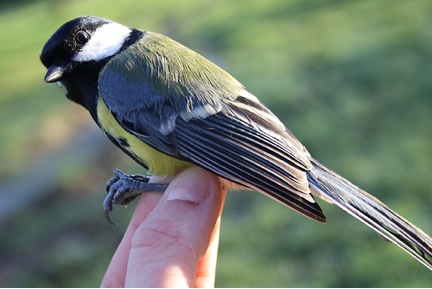Can flexibility help species avoid extinction?
Organisms keep up with a changing climate without waiting for genetic adaptation
Rebecca Cudmore • November 7, 2013

Great tits adjust their lifestyles to match changing temperatures [Image credit: Jules Bloom via Flickr]
Amid the potentially devastating effects of climate change on Earth’s biodiversity, there is growing evidence that some species— particularly those that are small and reproduce quickly—are holding off extinction with surprising flexibility in a changing world.
The secret to this evolutionary nimbleness is what biologists call “phenotypic plasticity.” The term refers to an organism’s ability to rapidly adjust to environmental change without having to wait for a favorable mutation in its genetic code. These highly “plastic” plants and animals are bypassing the slower evolutionary path of mutation and natural selection, and instead are taking a faster route to boost their survival chances.
The latest evidence comes from a newly published study in the journal PLoS Biology on a bird with a lemon-colored breast and a squeaky call once thought to foretell bad weather: the great tit.
Oscar Vedder, a research fellow at the Institute of Avian Research in Germany, led the study of great tits in Wytham Woods, near Oxford, one of the most closely monitored bird populations in the world. Analyzing 51 years of data, Vedder found the birds were adjusting to warmer temperatures by laying eggs earlier in the spring, thus increasing their chances of reproductive success.
Vedder found that for each degree Celsius the spring temperature increased, females laid their eggs about five days earlier. The great tits were able to adjust to a warmer overall climate, he concluded, because their hormonal systems were already sensitive to temperature swings between seasons. So when temperature within spring shifted subtly, the tits responded even though their genomes had not. “Without phenotypic plasticity at play, a [genetic] evolutionary response would be too slow,” said Vedder, and the Wytham population could have died out, as the chicks would be hatching after their food source had already peaked.
A similar hormonal mechanism is aiding the arctic fox. Usually grayish-brown in color, the fox grows a snowy white coat to stay camouflaged each winter in the tundra. While this ability to turn white is embedded in arctic fox DNA, it’s the hormonal response to decreased hours of daylight and lower temperatures that causes fox pigment-production to shut down.
Some plants have developed similar plasticity. Scientists have used the detailed records of famous naturalist, Henry David Thoreau, to observe how blueberries are flowering earlier than ever. Thoreau’s records from the 1850s show the highbush blueberry blooming mid-May in Concord, Massachusetts. Today, Concordians are enjoying blueberries as early as the first week of April. To keep up with warming temperatures, the berry plants have moved up their blooming times.
Since plants are immobile, this plasticity is essential. “They can’t simply move away under unfavorable conditions,” explained Katharina Braeutigam, a biologist at the University of Toronto. “They need to adjust and acclimate to existing conditions to survive.”
While it’s true that great tits and blueberries are benefiting from phenotypic plasticity, this does not refute forecasts of mass extinction due to climate change. Plasticity can help a particular species adjust to climatic shifts, but the species’ relationships to others can change with unforeseen consequences. “Climate change can have profound effects beyond the species level,” says Braeutigam. “It influences communities and whole ecosystems.”
Vedder explained that his study cannot be extrapolated to larger, slowly reproducing organisms. They are less plastic than small species and therefore must rely on evolutionary adaptation, a significantly slower process. Vedder said larger species have a hard time keeping up with changes in their environment, which he believes may be linked to the time it takes for each generation to replace itself.
And responsiveness to change isn’t always constant across a species. For example, a study of great tits in a Dutch national park found that the birds lagged behind the plasticity of their ecosystem. As the temperature warmed, biologist Marcel Visser of the Netherlands Institute of Ecology found that the budding times of oak trees shifted very quickly, as did the egg-laying cycles of the caterpillars that feed upon the oaks. But the great tits, which eat caterpillars, reacted much more slowly.
“These birds need to time their reproduction such that they lay early in years when their food is early and late in years when their food is late,” explained Visser. “They need to be plastic in their timing.” Because their hormonal systems were less sensitively attuned to temperature change, compared to the oaks and caterpillars, the tits missed the timing of their food for many years, and their population suffered.
So while it may be tempting to view phenotypic plasticity as an ‘evolutionary rescue mechanism,’ we are only beginning to understand how and when it works. Not all species are highly plastic, and even the ones that are can’t always pull through. “Plasticity clearly has its limits,” said Braeutigam. “Extinct and endangered species could not and can not just ‘cope’ with human-caused climate change.”
1 Comment
No one can say conclusively for sure why there are such big differences between the
various ethnic groups. It improves heart function and blood circulation which in turn improves metabolism.
Grey sugar may do but it becomes great to avoid sugar altogether and persist with honey.